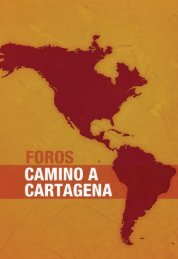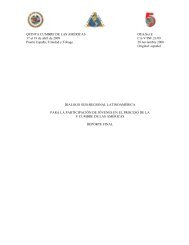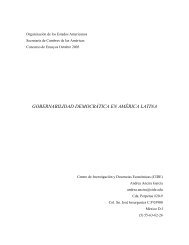The Road to Hemispheric Cooperation: Beyond the Cartagena
The Road to Hemispheric Cooperation: Beyond the Cartagena
The Road to Hemispheric Cooperation: Beyond the Cartagena
You also want an ePaper? Increase the reach of your titles
YUMPU automatically turns print PDFs into web optimized ePapers that Google loves.
Figure 1.3 Victimization Rate in Latin America, 2011<br />
45<br />
40<br />
35<br />
30<br />
25<br />
20<br />
15<br />
10<br />
5<br />
0<br />
Mexico<br />
Peru<br />
Argentina<br />
Costa Rica<br />
Colombia<br />
Bolivia<br />
Honduras<br />
Guatemala<br />
Ecuador<br />
Source: Jan van Dijk et al., <strong>The</strong> Burden of Crime in <strong>the</strong> EU – Research Report: A Comparative Analysis of <strong>the</strong> European Survey of Crime and<br />
Safety, 2005 8<br />
that of <strong>the</strong> countries of Western and Central Europe, which<br />
have <strong>the</strong> lowest indica<strong>to</strong>rs of criminal violence in <strong>the</strong> world.<br />
<strong>The</strong> remaining countries had intermediate rates, which are<br />
high none<strong>the</strong>less within <strong>the</strong> international context. Today,<br />
only 3 of <strong>the</strong> 18 Latin American countries (Chile, Argentina<br />
and Uruguay) exhibit homicide rates below <strong>the</strong> global rate<br />
(7.6 per 100,000 inhabitants in 2004). <strong>The</strong> latest United Nations<br />
report on homicides shows that among <strong>the</strong> 20 countries<br />
with <strong>the</strong> highest homicide rates in <strong>the</strong> world, 10 are<br />
located in LAC. 4<br />
If murderous violence affects Latin American countries in<br />
different ways, its impact is also diverse across <strong>the</strong> various<br />
socio–demographic groups. Particularly worthy of mention<br />
is <strong>the</strong> high concentration of regional homicide victims<br />
among men between 15 and 29 years of age, whose homicide<br />
rate in LAC (89.7 per 100,000) is nearly five times<br />
higher than <strong>the</strong> global figure (19.4 per 100,000). 5 Although<br />
femicide is a serious and possibly growing problem in <strong>the</strong><br />
region, <strong>the</strong> most notable feature of homicidal violence in<br />
LAC is <strong>the</strong> extreme disparity between homicide rates for<br />
men and women, unparalleled in <strong>the</strong> world. If globally <strong>the</strong><br />
ratio of murders of males <strong>to</strong> murders of females is 3.4 <strong>to</strong> 1,<br />
in Latin America <strong>the</strong> ratio stands at almost 11 <strong>to</strong> 1. 6<br />
Homicides are just <strong>the</strong> most visible part of <strong>the</strong> security challenge<br />
and <strong>the</strong> less problematic <strong>to</strong> quantify. When <strong>the</strong> inquiry<br />
includes o<strong>the</strong>r dimensions of <strong>the</strong> violence, <strong>the</strong> regional<br />
picture is, if anything, bleaker. In 2010, <strong>the</strong> proportion of<br />
households where someone was <strong>the</strong> victim of a criminal<br />
offense in <strong>the</strong> previous year was over 25 percent in nearly<br />
all Latin American countries. Unlike <strong>the</strong> rates of homicide,<br />
<strong>the</strong> regional data of victimization is quite homogeneous,<br />
with 13 out of <strong>the</strong> 18 countries ranging between 30 percent<br />
and 40 percent of households victimized per year. In any<br />
given year, over one-third of Latin Americans—200 million<br />
people—are victims of a criminal offense ei<strong>the</strong>r directly or in<br />
<strong>the</strong>ir immediate household. Today, <strong>the</strong> highest victimization<br />
<strong>The</strong> <strong>Road</strong> <strong>to</strong> <strong>Hemispheric</strong> <strong>Cooperation</strong>: <strong>Beyond</strong> <strong>the</strong> <strong>Cartagena</strong> Summit of <strong>the</strong> Americas<br />
<strong>The</strong> Brookings Institution ❘ Latin America Initiative<br />
62<br />
Brazil<br />
Venezuela<br />
Nicaragua<br />
Uruguay<br />
Paraguay<br />
Chile<br />
Dominican<br />
Republic<br />
El Salvador<br />
Panama<br />
Latin America








